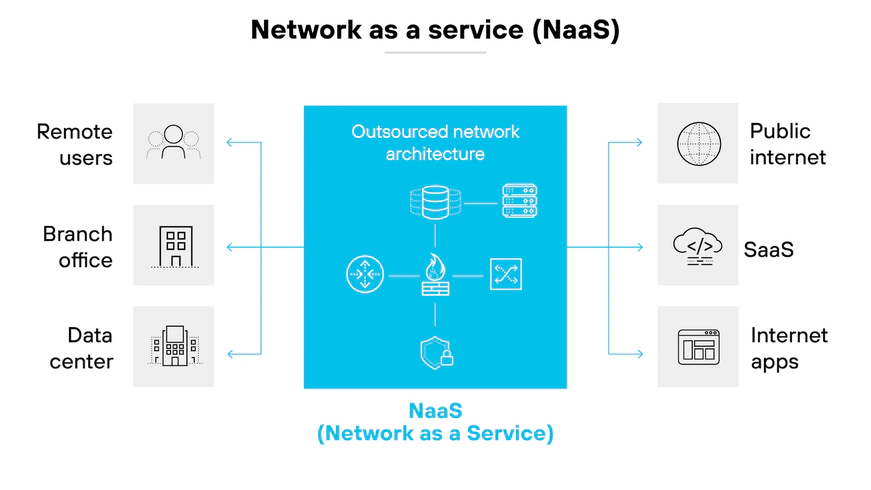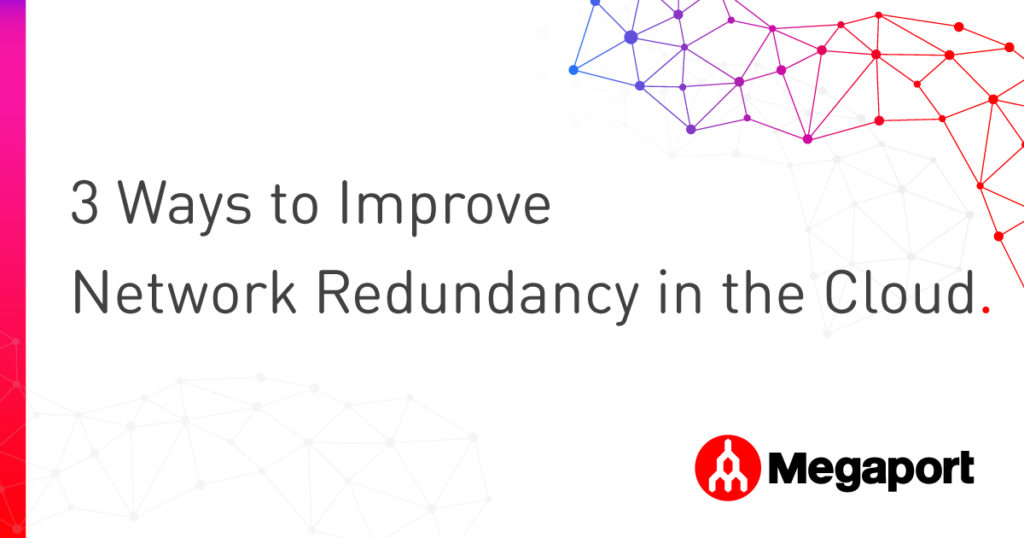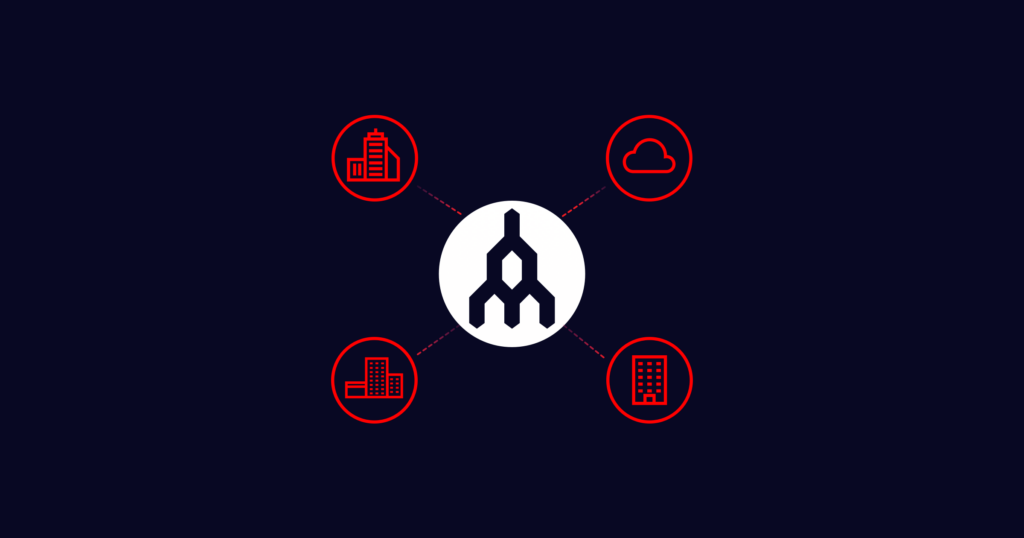
What is Network as a Service (NaaS)?
- Cloud networking
- April 2, 2025
- RSS Feed
By Chris Cabel, Senior Director, Global Cloud Solutions
Discover the advantages, use cases, and trends behind why this popular networking method is a must for businesses connecting to the cloud.
Table of Contents
What is NaaS?
NaaS is a cloud model where customers use third-party services to run their network as opposed to deploying and maintaining their own physical network infrastructure. This model shifts businesses from hardware-based to software-defined networking.
Born from the desire for businesses to configure their own wide area networks (WANs) that were more stable and performant than traditional setups, NaaS offers a subscription-based alternative to renting telco links and deploying your own infrastructure. Private connections between your Points of Presence (PoPs), cloud providers, and managed services can simply be used and scaled as needed.
This allows for easy business growth with global connectivity and interconnection across data centers, clouds, and regions, while removing the need to manage on-premises infrastructure.
NaaS typically replaces or modernizes setups like Multiprotocol Label Switching (MPLS) and virtual private networks (VPNs), and removes the need for on-premises hardware like load balancers and firewall appliances. This allows businesses flexibility in where and how they connect while reducing costs.

The trends driving NaaS growth
Before NaaS, businesses usually relied on private networks with rented links, onsite hardware, and internet VPNs to manage their WAN. But as cloud services became the norm, data traveling via corporate infrastructure and the public internet became increasingly inefficient, creating constant latency issues, jitter, traffic bottlenecks, and security concerns.
As networking technology has advanced, networking functions that used to be hardware-based (like firewalls and load balancers) can now be deployed and managed virtually. This enables employees to securely connect to cloud services directly through a virtual, externally-managed network as opposed to going through corporate VPNs and onsite WAN infrastructure.
By outsourcing their WAN to a NaaS provider, businesses are able to take full advantage of the applications and services cloud providers have to offer with improved performance, easier management, and more flexibility.
While NaaS is far from a new concept, it continues to grow in popularity for a number of reasons:
- Growing multicloud, hybrid cloud, and edge adoption add hops and complexity to traditional networks, making NaaS an attractive solution with its simple management.
- Post-COVID workforces have become increasingly hybrid, remote, and globally disparate, and NaaS’s on-demand global interconnection makes globally dispersed workforce management easy.
- Businesses contending with increasingly tight budgets are trying to do more with less. NaaS answers this need by reducing capex and allowing teams to scale as needed to rightsize costs.
- NaaS promotes a best-of-breed approach to connectivity, allowing businesses to take advantage of several different providers with no extra effort.
- Constantly-evolving cyberthreats call for constantly-evolving security protections. NaaS enables security solutions to be integrated from end to end on a private medium.
- Rapidly shifting priorities and projects are common in fast-moving online industries, like financial services and media. The agility of NaaS makes managing these shifting priorities easy with scalable bandwidth and fast deployment.
- Reducing hardware with NaaS contributes to more sustainable business practices, essential for hitting ESG goals, satisfying shareholders, and attracting customers.
- NaaS creates new possibilities for SD-WAN, SASE, virtual firewalls, cloud interconnection, bare metal, and even AI use cases, offering an integrated network layer on which to build a huge variety of future-focused business solutions.
Advantages of NaaS over traditional networking
Cost efficiency
By shifting your network infrastructure from hardware to software, you can eliminate the need to purchase routers, switches, firewalls, and circuits for (almost) no capex. And with the ability to connect to data centers, clouds, and partners without investing in colocation space or physical interconnects, you’ll continue to save capex over time.
A usage-based model also allows you to pay only for the connections you use, so you can budget more effectively and adjust your connectivity on demand to reduce opex.
Reliability
Software-defined networking comes with built-in redundancy and failover to minimize downtime. Traffic reroutes instantly if a connection fails, and diverse network paths across multiple data centers and regions protect high availability. Private NaaS connections are also protected from the instability of the public internet, eliminating bottlenecks.
Because of these advantages, many NaaS providers can offer high availability SLAs that give your team peace of mind and improve user experience for your customers.
Scalability
Elastic NaaS connectivity enables businesses to adapt to changing network demands without hardware constraints. Instantly increase or decrease capacity as needed to avoid overprovisioning, and virtually add or remove network connections in minutes.
You can also integrate and scale your cloud network by interconnecting multiple cloud providers and data centers, as well as automate network adjustments for dynamic workloads. And you can do all of this on a pay-as-you-go model with no long-term commitments.
Simplified management
Replace hardware-centric processes with centralized, software-driven control to manage all your global connections through a single pane of glass. Offload hardware management, updates, and troubleshooting to the provider, and improve the efficiency of your team with customizable APIs.
Integrated encryption, firewall policies, and compliance controls also work together to reduce the complexity associated with managing your network.
Improved performance
Software-defined routing enables you to bypass the public internet with private, high-speed links to clouds, data centers, and service providers, ensuring your data takes the most efficient possible path.
Adjust capacity in real time to prevent congestion and maintain peak performance. Dedicated links reduce packet loss and jitter, while the ability to adjust capacity in real time prevents congestion and enables you to rightsize your bandwidth.
Plus, distributed global backbones and access to multiple service providers allow for seamless interconnectivity with fewer hops. The result of all these benefits: more uptime, smoother operations, and faster time to market.
Fast deployment
The long lead and deployment times you’re used to with a traditional telco don’t exist with a NaaS provider. Software-defined orchestration replaces manual provisioning with automated, software-defined connectivity to set up your virtual connections in minutes via a self-service portal or API. Get direct, on-demand access to cloud providers, managed service providers, and colocation facilities. You can also quickly spin up or modify connections as business needs change.
Improved security
Reduce your attack surface and avoid exposure to internet-based threats with dedicated links, built-in security features, and end-to-end encryption on a private network underlay. Software-defined routing also supports Zero Trust Network Access (ZTNA) by restricting access based on identity and least-privilege principles.
Take your security a step further and use APIs to apply consistent encryption, segmentation, and compliance controls across all your connections.
Flexibility
Connect seamlessly across cloud environments with a vendor-neutral underlay built for multicloud and hybrid cloud support. Incorporate SD-WAN, SASE, MPLS, and bare metal setups to interconnect all your network endpoints and improve performance.
Traditional networking vs NaaS
Feature | Traditional networking | NaaS |
Costs | High capex and non-optimized opex | Reduced capex and optimized opex |
Reliability | Prone to downtime and bottlenecks | Built-in redundancy and failover |
Scalability | Scale bandwidth and add connections manually | Add bandwidth and connections virtually |
Management | Manual configuration and maintenance | Central portal, APIS, and/or automation |
Speed | Fixed bandwidth, instability of public internet | Scalable bandwidth, predictable latency |
Security | Public internet risks, BYO security features | End-to-end encryption, integrated security features |
Flexibility | Long lead times for deployment and growth | Deploy and scale in minutes with multicloud and hybrid cloud support |
Challenges of NaaS
If you’re considering a move from a traditional WAN network to NaaS, be mindful of the following challenges:
- Provider dependence: When you rely on a NaaS provider for availability, performance, or security, you become vulnerable to their outages or disruptions. Mitigate this by using a provider with as many global locations as possible, as well as a strong uptime SLA.
- Security considerations: Built-in security features can make businesses complacent, but you should still consider additional layers of network protection, such as customized encryption or measures to achieve compliance with specific regulatory standards.
- Limited customization: Large enterprises with highly complex network requirements may find NaaS solutions less customizable than traditional, fully on-premises infrastructure. In these instances, additional work may be required to optimize their setup with NaaS – although this investment of effort usually pays off.
- Legacy conflicts: Migrating your applications to NaaS may be more challenging if you have a primarily on-premises setup with legacy hardware. Look for a provider that offers hybrid cloud and edge services to integrate NaaS with your on-premises setups, and be prepared to upgrade a few components to become fully NaaS-compatible.
- Rigidity: Consider which systems and processes you build around your NaaS provider’s own processes, as these will make it more difficult to change providers and setups down the road.
NaaS vs other “as a service” offerings
Plenty of as-a-service models deliver IT resources on demand, but that serve slightly different purposes. Here are some common offerings you may hear about, and how they differ from one another.
- NaaS: focused purely on networking services, this cloud-based model provides on-demand networking capabilities for businesses needing scalable, high-performance, and secure networking without managing hardware.
- Platform as a Service (PaaS): a cloud-based platform that provides application development and deployment tools. Developers can use PaaS to build and manage applications without managing servers or infrastructure.
- Software as a Service (SaaS): a cloud-based software delivery model where users access applications via a web browser without installing or maintaining software. SaaS is widely used by businesses and individuals for productivity, communication, or collaboration – for example, Google Workspace and Microsoft 365.
- Infrastructure as a Service (IaaS): a cloud computing model that provides virtualized computing resources, like servers, storage, and networking, on a pay-as-you-go-basis. Organizations needing flexible, on-demand IT infrastructure can use IaaS without physical hardware investment.
- Desktop as a Service (DaaS): a cloud-based virtual desktop solution where users access their desktop environment remotely via the internet. DaaS solutions are ideal for businesses with remote workforces needing secure, scalable desktop environments.
Service | Purpose | Key benefit | Example provider |
NaaS | Cloud-based networking | On-demand connectivity | Megaport |
PaaS | Development and deployment platform | Simplifies app development | Google App Engine |
SaaS | Software applications | No installation, accessible anywhere | Salesforce |
IaaS | Virtualized infrastructure | Scalable compute, storage, and networking | AWS EC2 |
DaaS | Cloud-hosted desktops | Secure remote desktop access | Azure Virtual Desktop |
Use cases for NaaS
- Cloud-first businesses: Connect seamlessly to public and private clouds.
- Real-time industries: Improve uptime, reduce latency, and scale on-demand for time-sensitive network operations like streaming, finserv markets, and online retail sales.
- Global enterprises: Simplify interconnection across all your global locations and providers.
- Hybrid cloud architectures: Ensure secure and scalable connectivity between your on-prem and cloud.
- Remote and distributed teams: Maintain secure, high-performance network access across every network endpoint.
- Branch networks: Scale your network without onsite IT teams and optimize connectivity to the branch – ideal for industries like healthcare and retail.
How to get started with NaaS
With a completely virtual setup, it’s easy to get started with NaaS – just choose your provider and follow their instructions to spin up your connections.
Look for a provider with:
- a large and constantly growing ecosystem of global locations, providers, and integrations
- a high uptime SLA
- a wide range of add-on solutions like cloud interconnects, virtual firewalls, and direct internet
- a simple portal and their own APIs/automation capabilities
- high bandwidth options to cater to any data need
- security certifications like ISO/IEC 27001.
Searching for the perfect NaaS provider? Check out Megaport. We offer a huge range of networking solutions on our elastic network fabric, we’re available in 930 + global locations, and you can spin up most of our services in under 60 seconds.
Discover how other businesses have used Megaport’s NaaS to transform their business.
Want to get straight to the point? Chat to one of our experts for a free personalized demo.


